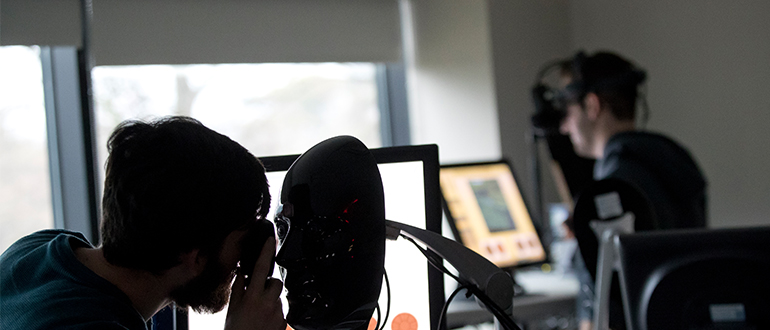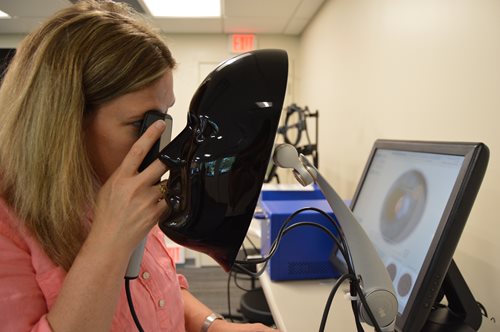
One of the stages of the University’s five year Strategic Plan and Master Facilities Plan, implemented in 2015, was to “provide facilities and technology that provide the appropriate infrastructure to promote state-of-the-art education and clinical programs” in addition to “investing in technologies, teaching methodologies, and evidence-based standards and practices that foster excellence in education, clinical and business processes.” That being said, the opening and completion of the Virtual Reality Simulation Lab adjacent to the Clinical Procedures Lab were two of these major initiatives to keep Salus at the forefront of optometric education delivery.
Featuring state-of-the-art VRmagic equipment and software for virtual retinal examinations, Dr. Rachel Brackley, assistant professor in the University’s Pennsylvania College of Optometry (PCO) and committee chair for the renovation project, was pleased to see the lab completed in 2017.
She was also excited about the increased educational opportunities it would provide PCO students as budding optometrists. The VR lab introduces the skills of direct ophthalmoscopy and indirect ophthalmoscopy earlier in the curriculum. It also allows students to work on skills at their own individual pace, and receive immediate feedback about what they are examining. The skills can be difficult to learn, but with the VRmagic software, students can master the skills more quickly.
Another major facet of the University’s strategic planning priorities is to continually enhance academic programs in addition to the commitment of graduating the highest caliber professionals – the VR lab has certainly helped students hone their clinical skills prior to delivering patient care at The Eye Institute (TEI).
“Having a virtual patient in the simulation lab is great because I can practice how to properly hold the condensing lens for a Binocular Indirect Ophthalmoscopy (BIO) and figure out how to maneuver around the ‘patient’ before going to clinical skills lab and practicing on my classmates,” said Sonia Panchal ‘21OD.
The Virtual Reality Simulation Lab includes eight stations for indirect ophthalmoscopy and four for direct ophthalmoscopy. Each station is equipped with a touch-screen monitor, a model patient head, and the tools needed for either direct or indirect ophthalmoscopy. The indirect ophthalmoscopy stations also include a wearable headset with a display monitor.
 The VRmagic software has various modules users can select to test a variety of skills such as properly using an ophthalmoscope, finding shapes on the retina, examining objects found on a retinal map, locating and identifying retinal pathologies, and using a case-study format to examine a model patient. One of the features of the lab that stands out is the capability to have the simulator projected for group learning, further enhancing the students’ understanding of the cases and concepts being reviewed.
The VRmagic software has various modules users can select to test a variety of skills such as properly using an ophthalmoscope, finding shapes on the retina, examining objects found on a retinal map, locating and identifying retinal pathologies, and using a case-study format to examine a model patient. One of the features of the lab that stands out is the capability to have the simulator projected for group learning, further enhancing the students’ understanding of the cases and concepts being reviewed.
University president Dr. Michael H. Mittelman had the privilege of being one of the first to test the new equipment back in 2017. He was astounded by the life-like 3D modules and believes the technology will greatly enhance students’ clinical training.
“The fidelity of this new teaching tool was remarkable,” he said. “This lab helps to set us apart from other programs in the country.” At the time the VR lab opened in 2017, PCO was one of less than half of the 24 colleges of optometry with this technology.
Dr. Brackley agreed that the Virtual Reality Simulation Lab would help set Salus PCO apart as staying current with the latest optometric training and clinical tools, which will always be crucial to students’ success.